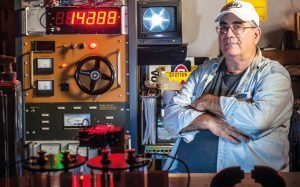Will Dunn in New Statesman:
 For his eighth birthday, Richard Hull’s mother bought him a Geiger counter. It was 1955 and the United States was testing nuclear weapons on its own soil. “They would always announce a test in the newspaper,” Hull remembers. “The material that went into the stratosphere drifted with the prevailing winds. The radioactive fallout particles came down with rain, as far north as New York and as far south as Georgia.” Hull lived then, as now, in Virginia, squarely in the path of the fallout that blew east from the bombs in the Nevada desert. “We would have days when we couldn’t have milk,” he remembers, “because of the strontium-90.” Hull wanted a Geiger counter not because he was afraid of radioactivity, but because he was enthralled by it. He pointed his new toy at anything that might make it tick, from wristwatches to rocks, and he collected fallout from the bombs. “I would take bird-bath water, or water that I gathered in pails from the downspouts of the house, and I would slowly evaporate that water on my mother’s stove, and that would leave the solids behind. And they were highly radioactive,” he says, with evident satisfaction.
For his eighth birthday, Richard Hull’s mother bought him a Geiger counter. It was 1955 and the United States was testing nuclear weapons on its own soil. “They would always announce a test in the newspaper,” Hull remembers. “The material that went into the stratosphere drifted with the prevailing winds. The radioactive fallout particles came down with rain, as far north as New York and as far south as Georgia.” Hull lived then, as now, in Virginia, squarely in the path of the fallout that blew east from the bombs in the Nevada desert. “We would have days when we couldn’t have milk,” he remembers, “because of the strontium-90.” Hull wanted a Geiger counter not because he was afraid of radioactivity, but because he was enthralled by it. He pointed his new toy at anything that might make it tick, from wristwatches to rocks, and he collected fallout from the bombs. “I would take bird-bath water, or water that I gathered in pails from the downspouts of the house, and I would slowly evaporate that water on my mother’s stove, and that would leave the solids behind. And they were highly radioactive,” he says, with evident satisfaction.
For Hull and others like him, radioactivity is not a poison but a thrill, a kind of life within materials. The uranium we find on Earth, he explains, has been ticking away since before the planet itself was formed. “It has been decaying since the supernova that blew the material off and [it] slowly accreted into the Earth, billions of years ago. And it’s still going today. That fascinated me,” he says. “It still does.” This fascination has led Hull to experiment with radioactivity for more than 60 years. Under Eisenhower’s educational “Atoms for Peace” programme, a schoolchild in the 1950s could order small quantities of radio isotopes to their home, so Hull wrote to the US nuclear facilities for free samples of caesium-137, sulphur-42 and cobalt-60. Following a guide in Scientific American, he contaminated clover plants with radio-phosphorus and laid them on photographic paper, creating radiographic pictures of the veins within the leaves.
More here.
